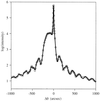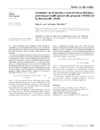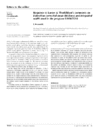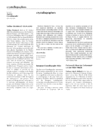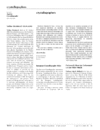issue contents
December 2000 issue

Cover illustration: Reorientation pathways of the octahedral PF6 anion in KPF6, calculated by an evolution algorithm. Courtesy of K. Knorr (University Kiel, Earth Sciences - Mineralogy) and Fritz Mädler (HMI Berlin) [J. Appl. Cryst. (1999), 32, 902-910].
research papers
A procedure is described for completing a partial crystal structure model via the prior information on the coordination polyhedra.
The formula of the pseudo-Voigt function is extended in order to improve the accuracy when approximating the Voigt profile. When the extended formula is applied for curve fitting to a Voigt profile, the accuracy of the estimated profile parameters can be improved considerably.
Variations of the line shape of the Kα1–Kα2 doublet beam reflected from a parabolic graded multilayer were analysed by ray tracing and rocking-curve measurements.
Formulae for estimating statistical uncertainties in quantitative phase analysis using the Rietveld method and the whole-powder-pattern decomposition method have been derived. They provide guidelines for optimizing experimental parameters in order to obtain a required precision.
A new evaluation method and its application are discussed in detail for the determination of some important statistical parameters of a dislocation assembly, namely the average dislocation density, the average fluctuation of the dislocation density and the average polarization, from the X-ray diffraction line profile.
A Fourier transform of a Debye–Scherrer diffraction pattern can be used to estimate the characteristic size of nanoparticle samples. This method is insensitive to nanoparticle structure and therefore preferable to the Scherrer formula (which is unreliable because it assumes an underlying size-limited perfect crystal structure).
A surface X-ray diffractometer is presented. Features include separate detector and sample circles allowing choice of horizontal or vertical sample geometries, accommodation of a variety of detector systems and a novel fast data collection system.
Using X-ray diffraction and infrared spectroscopy, the structures of the intercalated compounds of nacrite with dimethyl sulfoxide (DMSO) and N-methylacetamide (NMA) have been determined, including the mutual positions of the layers after intercalation and the positions of the intercalated molecules in the interlayer space. It has been shown that the intercalation process causes not only a swelling of the interlayer space but also a shift in the mutual in-plane positions of the layers.
The effects of the variation of the chemical, electrical and thermal parameters of the aluminium anode oxidation process on the hardness level of the resulting oxide layer have been studied. In order to quantify the relationships that govern the kinetics of the anode oxidation process, these data were subjected to analysis employing a central compositional rotatory programming matrix.
A general integral form of the integrated intensity of a rocking scan in z-axis type surface X-ray diffraction measurements is presented, which allows an accurate derivation of the structure-factor amplitude. The intensity line shape is stimulated on the basis of the in-plane distribution of rods, by considering the specific scattering geometry of any point of the illuminated sample surface with respect to the detector slit setting.
A new method of analysing X-ray peak broadening caused by local tilt distribution is proposed. The method is useful for simple identification of X-ray peak broadening caused by local tilt distribution for samples with mosaic structures.
An enhanced polydisperse model for small-angle scattering intensity for a diluted system of spherical precipitates with diffusion zones is presented. A nonlinear regression based on the analytic result supplies parameter values and confidence intervals to verify the inhibitor concept of nanocrystallization in amorphous alloys.
Phase-space methods are used to describe the resolution of a combination of two collimators and a monochromating crystal for various combinations of novel neutron beam optical elements. The description of rectangular-profile elements in this formalism considerably simplifies the normal description of resolution effects and should thus prove useful as a teaching tool.
Phase-space arguments are used to discuss the resolution of neutron scattering instruments, under the assumption that all beam elements have rectangular profiles, which results in considerable clarification of the role of each instrument component. The formalism is extensible to Gaussian-profile elements and the results should be applicable to other diffraction techniques.
Expressions for the calculation of ω–ψ scans are derived within the framework of the kinematical theory. The theoretical result is compared with the Cu Kα  multiple-diffraction pattern of diamond.
multiple-diffraction pattern of diamond.
Bayesian estimation of hyperparameters for indirect Fourier transformation in small-angle scattering
Bayesian analysis is applied to the problem of estimation of the hyperparameters necessary for indirect Fourier transformation in small-angle scattering. It is shown how the use of probability theory eliminates the traditional problem of having to choose the noise level as well as the maximum dimension of the scatterer.
The feasibility of the use of a charge-coupled device (CCD) in combination with an X-ray image intensifier for perturbation crystallography, where small changes in integrated intensity are to be detected, is investigated. The system proved to be sufficiently accurate and stable to measure changes in integrated intensity below 0.1%.
short communications
Quantitative information on a subsurface layer structure is obtained through the determination of the photoelectron escape depth by using the photoelectrons emitted by an X-ray standing wavefield in the range of dynamical X-ray diffraction from high-quality crystals. A simple method to determine the mean escape depth L of low-energy-loss photoelectrons is proposed, based on the analysis of the phase of the X-ray standing wavefield in a specially designed epitaxic structure grown by molecular-beam epitaxy.
The assumption that the pole-density profile of a powder specimen can be described by a March function, with coefficient R, leads to an intensity correction factor in Debye–Scherrer geometry that can be approximated quite well by another March function, with coefficient R−1/2.
computer programs
A new vector-search rotation function has been implemented in a computer program called OVIONE. The rotation search is followed by a refinement of the highest peaks from the rotation function, both procedures being carried out in Patterson space.
Molsee is a GUI front end for Rasmol. It is more convenient to use Molsee to control Rasmol than Rasmol itself.
letters to the editor
Free 

Free 

addenda and errata
Free 

crystallographers
Free 

Free 

Free 



 journal menu
journal menu


























